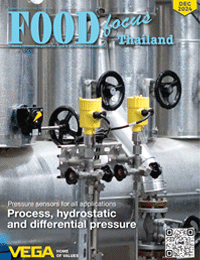ก้าวต่อไปของการพัฒนาอย่างยั่งยืนในอุตสาหกรรมอาหารทะเล The Next Wave: Shaping the Future of Sustainable Seafood
124 Views |

ก้าวต่อไปของการพัฒนาอย่างยั่งยืนในอุตสาหกรรมอาหารทะเล
The Next Wave: Shaping the Future of Sustainable Seafood
By: กองบรรณาธิการ
นิตยสาร ฟู้ด โฟกัส ไทยแลนด์
Editorial Team
Food Focus Thailand Magazine
editor@foodfocusthailand.com
ประเทศไทยมีแหล่งทรัพยากรทางทะเลที่อุดมสมบูรณ์ อันมีส่วนสำคัญในการขับเคลื่อนอุตสาหกรรมอาหารทะเลโลก ด้วยปัจจัยสนับสนุนด้านที่ตั้งทางยุทธศาสตร์ แรงงานที่มีทักษะ รวมถึงภาคการเพาะเลี้ยงสัตว์น้ำและการประมงที่แข็งแกร่ง ส่งผลให้ประเทศไทยเป็นผู้ส่งออกอาหารทะเลรายใหญ่อันดับ 8 ของโลกในด้านปริมาณ และอันดับ 14 ของโลกในด้านมูลค่า โดยแนวโน้มสำคัญของการพัฒนาอุตสาหกรรมอาหารทะเลอย่างยั่งยืน มีดังนี้
1. พัฒนาแหล่งอาหารทะเลให้มีความหลากหลายและยั่งยืน
เทคโนโลยีการประมงแบบแม่นยำของบริษัท Ava Ocean ของประเทศนอร์เวย์ได้ใช้ปัญญาประดิษฐ์ค้นหาและจับสัตว์ทะเลเฉพาะชนิด ซึ่งช่วยลดการทำลายปะการังและสัตว์ทะเลอื่นๆ ที่ไม่ต้องการ อีกทั้งยังมีความสอดคล้องกับกฎระเบียบสากลที่เข้มงวดมากขึ้น ส่วนการเพาะเลี้ยงสัตว์น้ำ เช่น กุ้งและปลาในระบบปิด (Recirculating Aquaculture Systems; RAS) ช่วยให้มีการนำของเสียในระบบกลับมาใช้ใหม่ด้วยการบำบัดและกรองอย่างมีประสิทธิภาพ อีกทั้งยังช่วยลดการพึ่งพาการจับสัตว์น้ำในทะเลได้อีกด้วย
2. ใช้เทคโนโลยีตรวจสอบกระบวนการเลี้ยงสัตว์น้ำที่ทันสมัย
เทคโนโลยีเซนเซอร์ IoT หุ่นยนต์ ระบบอัตโนมัติ และโดรน กำลังปฏิวัติการเพาะเลี้ยงสัตว์น้ำ ซึ่งเป็นภาคส่วนสำคัญในการผลิตอาหารทะเลอย่างยั่งยืน นวัตกรรมเหล่านี้ช่วยให้การตรวจสอบระยะไกลมีประสิทธิภาพมากขึ้น รวมถึงช่วยลดต้นทุนการดำเนินงาน และปรับปรุงสวัสดิภาพของสัตว์น้ำ
3. เพิ่มความโปร่งใสและความยั่งยืนด้วยการรับรองจากองค์กรภายนอก
อุตสาหกรรมอาหารทะเลให้ความสำคัญกับความยั่งยืนและความสามารถในการตรวจสอบย้อนกลับมากขึ้นเพื่อตอบสนองต่อความต้องการของผู้บริโภคที่ใส่ใจสุขภาพและสิ่งแวดล้อม โดยฉลากรับรองจากองค์กรอิสระ เช่น มาตรฐาน MSC (การรับรองอาหารทะเลจากการทำประมงแบบธรรมชาติอย่างยั่งยืน) และมาตรฐาน ASC (การรับรองอาหารทะเลจากการเพาะเลี้ยงอย่างยั่งยืน) กลายเป็นมาตรฐานใหม่ที่ผู้บริโภคใช้พิจารณาว่าผลิตภัณฑ์อาหารทะเลนั้นมาจากแหล่งผลิตที่ยั่งยืนและมีการจัดการอย่างถูกต้อง
4. ประยุกต์ใช้นวัตกรรมแช่แข็งอาหารทะเลเพื่อความยั่งยืน
เทคโนโลยีการแช่แข็งแบบยั่งยืนกำลังปฏิวัติวิธีการถนอมอาหารทะเลให้ดียิ่งขึ้น โดยช่วยเพิ่มคุณภาพ ลดของเสีย และสนับสนุนเป้าหมายด้านสิ่งแวดล้อม เช่น การแช่แข็งแบบไอโซคอริก (Isochoric Freezing) สามารถลดการใช้พลังงานลงได้มากถึง 6.5 พันล้านกิโลวัตต์ต่อชั่วโมงต่อปี และลดปริมาณการปล่อยก๊าซคาร์บอนได้ถึง 4.6 พันล้านกิโลกรัม ซึ่งสามารถทำได้โดยไม่จำเป็นต้องปรับเปลี่ยนอุปกรณ์และโครงสร้างพื้นฐานของการผลิต
5. เพิ่มมูลค่าให้ผลพลอยได้จากอาหารทะเล
ผลิตภัณฑ์เหลือทิ้งจากปลา เช่น หัว กระดูก ครีบ และหาง สามารถพัฒนาเป็นผลิตภัณฑ์ที่มีมูลค่าสูงอย่างน้ำมันปลาแทนที่จะนำไปผลิตเป็นปลาป่น นอกจากนี้ ยังสามารถนำสารสกัดไปใช้เป็นส่วนผสมอาหารประเภทต่างๆ เช่น สารสกัดจากหัวปลาหมึกที่นำไปปรุงรสเคลือบถั่วลิสง สารสกัดจากเปลือกกุ้งที่นำไปเคลือบขนมขบเคี้ยว เป็นต้น
Thailand, a maritime nation with abundant marine resources, is a significant player in the global seafood industry. The country's strategic location, skilled workforce, and robust aquaculture and fishing sectors contribute to its position as the world's eighth-largest seafood exporter by volume and fourteenth by value. To this end, several key global trends in the seafood industry are worth considering.
1. Shift towards diversified, sustainable sources
Precision fishing, developed by companies like Norway's Ava Ocean, uses AI to identify and carefully capture specific seabed species. This targeted approach minimizes environmental impact and meets increasingly strict regulations, offering a sustainable solution in fragile marine ecosystems. Indoor aquaculture is also rising, with recirculating aquaculture systems (RAS) providing controlled environments for fish and shrimp. These systems allow waste recycling through effective treatment and filtration processes and reduced reliance on wild stock.
2. Leverage advanced aquaculture inspection technologies
Aquaculture is experiencing a technological revolution with the integration of IoT sensors, robotics, automation, and drones. These innovations enable more efficient remote monitoring, reducing operational costs and improving the welfare of farmed fish.
3. Improve seafood transparency and sustainability with third-party certification programs
The seafood industry is increasingly prioritizing sustainability and traceability. Eco-labels like the Marine Stewardship Council (MSC) and Aquaculture Stewardship Council (ASC) are gaining popularity, driving demand for sustainably sourced seafood. Traceability systems are crucial for ensuring food safety, combating illegal fishing, promoting sustainable practices, building consumer trust, and streamlining supply chain efficiency.
4. Implement innovative technologies for sustainable freezing in seafood
Sustainable freezing technologies are enhancing seafood preservation by improving quality, reducing waste, and supporting environmental goals. Methods like isochoric freezing could cut energy use by as much as 6.5 billion kilowatt-hours each year while reducing carbon emissions by 4.6 billion kg without requiring major investments in new equipment or production.
5. Seek to unlock the economic value of seafood by-products
Traditionally underutilized fish byproducts, like heads, bones, fins, and tails, are now being transformed into valuable products such as fish oil instead of fishmeal to increase their market worth. Additionally, the extract can also be used as an ingredient in various types of food, such as squid head extract used to season and coat peanuts, or shrimp shell extract used to coat snacks.





